SYNCHRON-ized Special Editions 1 - Essential Orchestra
Introduction
Welcome to the Vienna Symphonic Library's series of Synchron Instruments! The SYNCHRON-ized Special Editions were specifically created to give our renowned Vienna Special Editions a chance to shine in the unique acoustic ambience of the Vienna Synchron Stage, and make the ease-of-use of the Vienna Synchron Player available to them, and you. This document will provide you with information about the Libraries' instruments and structure.
For creating SYNCHRON-ized Special Editions, our sound editors went back to the raw, unprocessed sample data of the Vienna Special Edition Collections. The original recordings were completely re-edited and re-mastered in order to achieve an all-new, modern sound that excels in terms of aesthetics, playability and realism, and that is optimized for use alongside the Synchron Series instruments.
Included Presets
For SYNCHRON-ized Special Editions, our software developers added a specifically designed convolution reverb derived from Vienna MIR Pro to the Synchron Player, featuring the outstanding and unique ambience of the 540 m2 (5,813 sq.ft.) main hall of Synchron Stage Vienna. The perfectly engineered reverberation and placement presets combine customized impulse responses with expertly crafted reverb settings for each group of the ensemble. By adding the ambience of Synchron Stage Vienna's Stage A to the dry samples in real-time, SYNCHRON-ized Special Editions perfectly blend with other products of our Synchron Series.
For each instrument, there are dedicated Mixer Presets that depict different recording situations: Close, Classic, Distant, short and long reverb without convolution.
Sound categories
The Presets of each instrument group are subdivided into different Articulation categories (plus one named "Custom", ready for your own creations).
Strings
- Short Notes
- Long Notes
- Legato
- Dynamics
- Tremolo + Trills
- Pizzicato + Legno
- Harmonics
- Sul ponticello
- Con sordino (Orchestral strings)
Wind instruments
- Short Notes
- Long Notes
- Legato
- Dynamics
- Trills + Fast repetitions
Within these Articulation categories, you can select a Type (if applicable), e.g., staccato or détaché, and for some of the types there are additional options available, such as marcato attack or tremolo control.
The articulations of other instruments, such as percussion and keyboards, depend on the specific instrument's requirements and capabilities.
Custom Presets
Apart from its respective categories, every instrument also features a slot named "Custom Preset". It does not yet contain any samples, and provides slots ready for you to load patches and configure presets of your own.
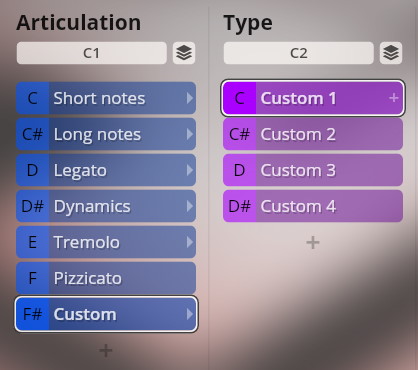
Synchron D-274 Piano
The Synchron D-274 is part of the SYNCHRON-ized Special Edition Volume 1. Please note that to be able to use the piano, you will have to download and install the latest version of the Vienna Synchron Pianos Player software.
For further information on working with the software, please refer to the dedicated Synchron Pianos manual. You can download both software and manual from MyVSL.
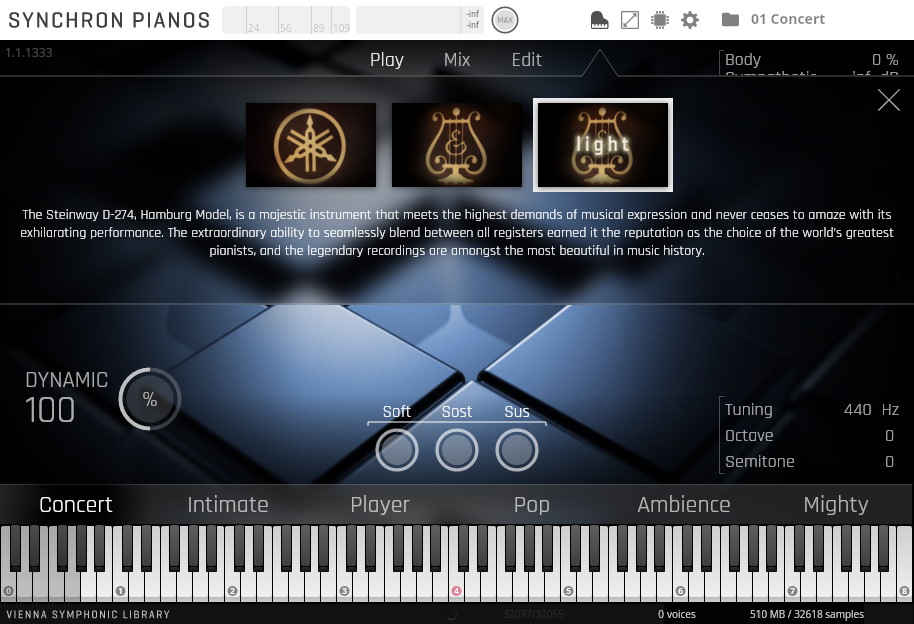
About Patches
Patches can be used to build your own custom Presets and adapt the Synchron Libraries to your specific requirements. If you want to create Presets of your own, using the instruments' Custom Preset template provides a good starting point.
About Pitch
For designating pitch, the Vienna Symphonic Library uses International Pitch Notation (IPN), which was agreed upon internationally under the auspices of the Acoustical Society of America. In this system the international standard of A=440 Hz is called A4 and middle C is C4. All pitches are written as capital letters, their respective octave being indicated by a number next to it. The lowest C on the piano is C1 (the A below that is A0), etc.
The Synchron Player software allows you to set middle C to C3, C4, or C5 according to your preference. Selecting another setting than C4 will of course also change the play ranges and keyswitches accordingly.
Walkthrough Videos
Special Edition 1 / 1 Plus – Presets
By default the keyswitch mappings for Articulations start at C1 (for Middle C = C4) for treble and mid-range instruments (e.g., violins, clarinet), and C6 for low instruments (double basses, bassoon). For the available Types, the keyswitches start at C2 for higher instruments, and at C7 for lower ones.
Additional options within Articulations or Types are offered by the Dimension Controllers. The controller function is indicated by the respective caption, as of course it may take on different tasks as needed.
01 Solo Strings, 03 Orchestral Strings
The keyswitch mapping for Articulations starts at C1 (Middle C = C4) for violins, violas, and cellos, and at C6 for the double basses.
For the available Types, the keyswitches are mapped from C2 for violins and violas, and from C7 for cellos and basses.
The orchestral strings also feature a "multi convolution" and a "flat stereo" Preset, both of which combine all string sections (with an overall playing range from B0 to D7) with their basic articulations except legato.
Short notes
Regular
Staccato and regular détaché. There are no further options to these articulation types.
Please note that the "regular" Type keyswitches of short notes are mapped to white keys only. This makes it easier to switch to "Plus" later as the détachés will still be triggered by playing D2 (violins, violas) or D7 (cellos, basses) on the keyboard or entering the respective note in your sequencer – meaning also that you will not have to change an existing composition.
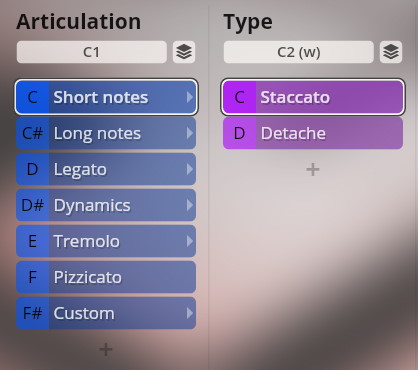
Plus
Staccato, short and regular détaché, legato and spiccato performance repetitions.
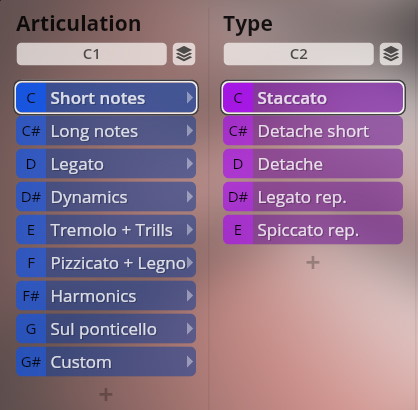
Long notes
Sustained notes, normal, marcato, and with tremolo crossfading. The articulation types are the same for the regular and Plus versions.
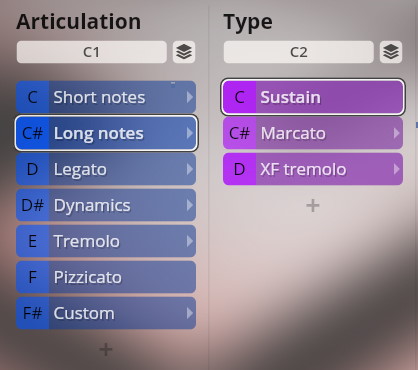
Marcato
As with regular sustains, but with the option to use Dim.Ctrl/A (CC1) to add marcato attacks to the notes.
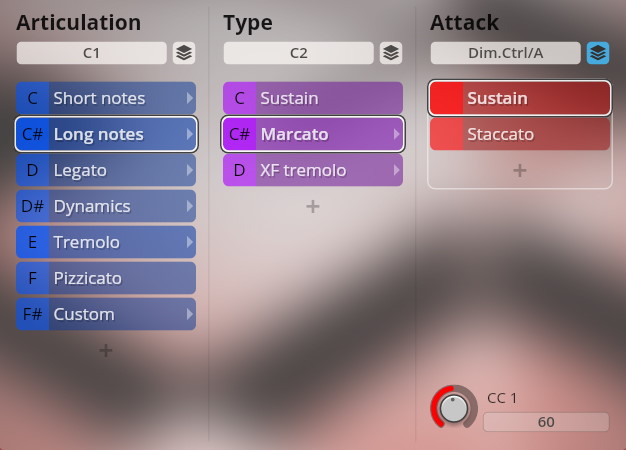
XF tremolo
Use Dim.Ctrl/B (CC20) to crossfade between regular sustains and tremolo.
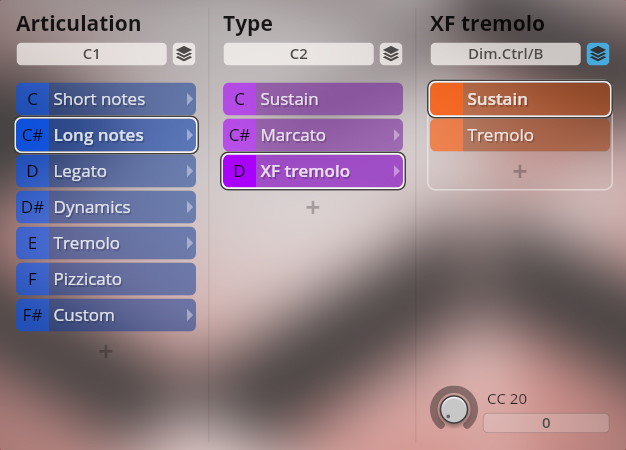
Legato
Performance legato and portamento. The articulation types are the same for the regular and Plus versions.
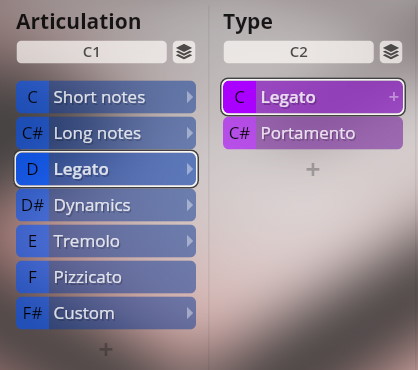
Dynamics
Regular
Sforzato, regular and with tremolo crossfading.
With the tremolo option, use Dim.Ctrl/B (CC20) to crossfade between regular sforzato and tremolo.
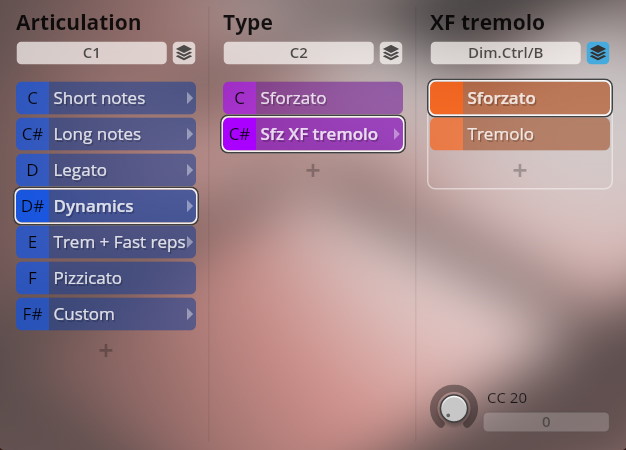
Plus
Sforzato and fortepiano, regular and with tremolo crossfading.
With the tremolo option, use Dim.Ctrl/B (CC20) to crossfade between regular and tremolo articulations.
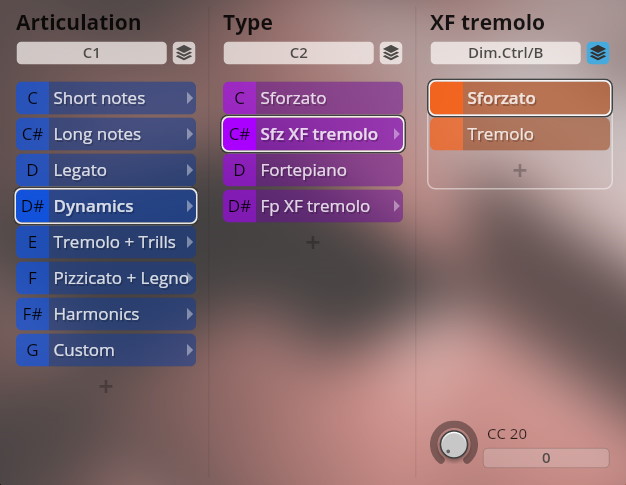
Tremolo / Tremolo + Trills
Regular
Tremolo sustains, regular and with marcato attack.
With the marcato option you can use Dim.Ctrl/A (CC1) to add marcato attacks to the tremolo notes.
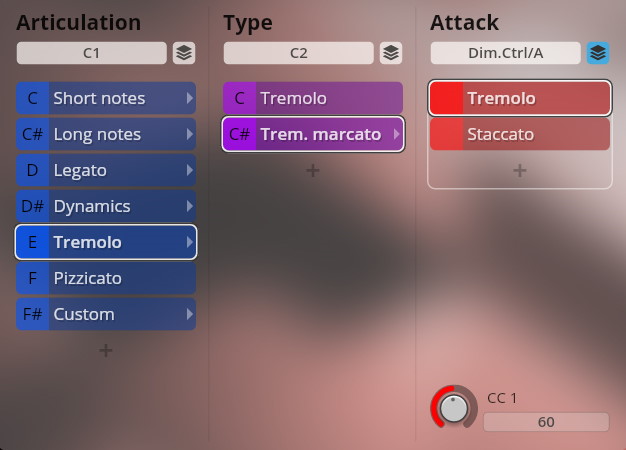
Plus
Tremolo sustains, regular and with marcato attack, half and whole tone trills, and fast repetitions at 150, 170, and 190 BPM.
With the tremolo's marcato option you can use Dim.Ctrl/A (CC1) to add marcato attacks.
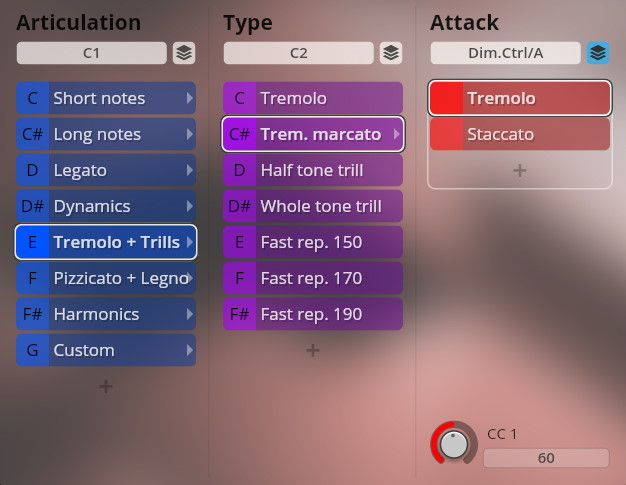
Pizzicato / Pizzicato + Legno
Regular
Pizzicato.
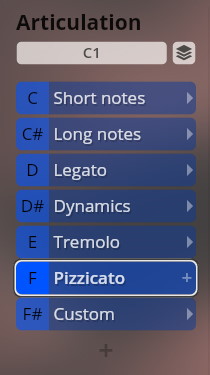
Plus
Pizzicato, snap pizzicato, and col legno.
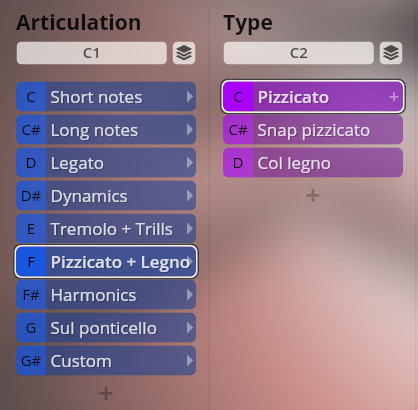
Harmonics (Plus only)
Artificial harmonics, staccato and sustained. With the marcato option you can use Dim.Ctrl/A (CC1) to add marcato attacks to the sustained notes.
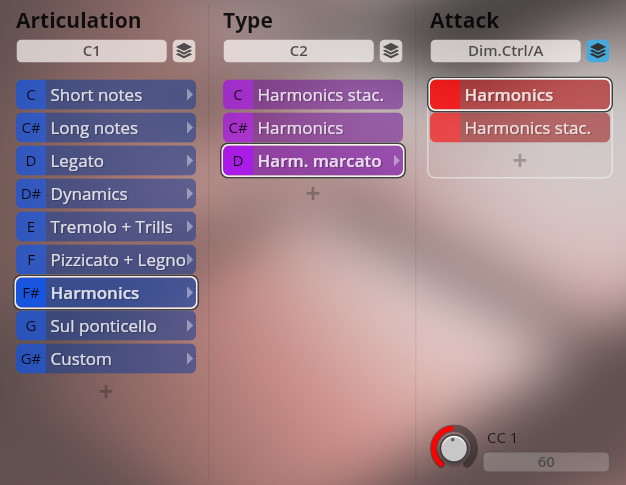
Sul ponticello (Plus only)
Sul ponticello, staccato, sustained, marcato, and tremolo. With the marcato option you can use Dim.Ctrl/A (CC1) to add marcato attacks to the sustained notes.
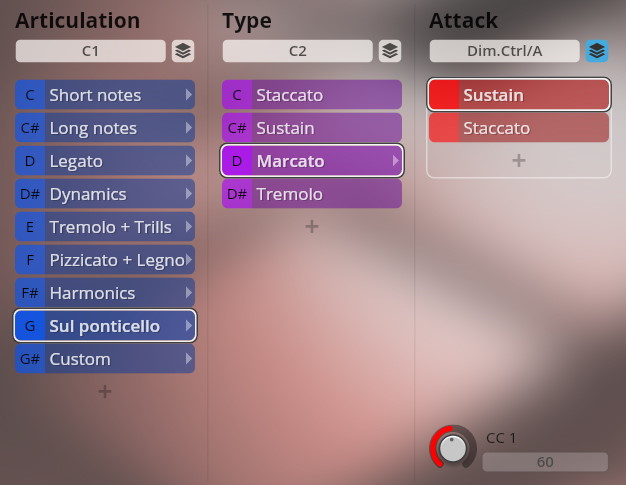
Con sordino (Orchestral Strings / Plus only)
Con sordino, staccato, sustained, marcato, and tremolo. With the marcato option you can use Dim.Ctrl/A (CC1) to add marcato attacks to the sustained notes.
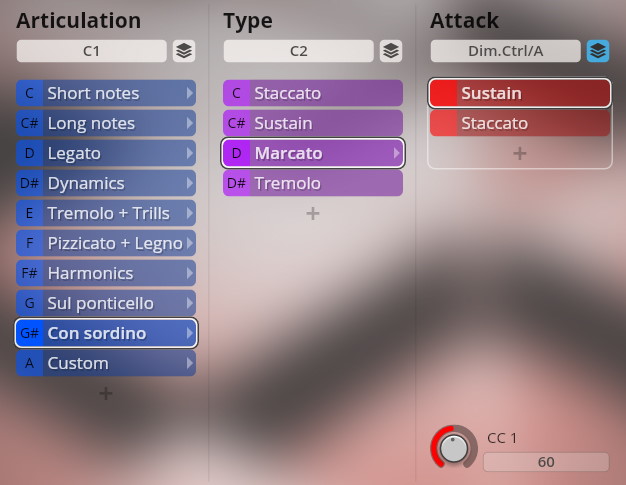
06 Plucked Instruments
01 Harp 1
Regular notes, and harmonics.
Articulation keyswitches: A0, A#0
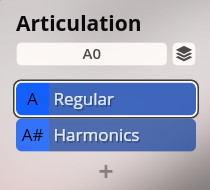
Winds
Staccato / Short notes
Regular
Staccato.
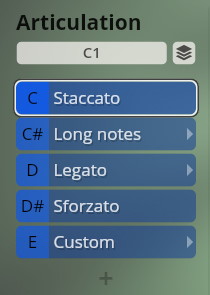
Plus
Staccato, portato, legato and staccato performance repetitions.
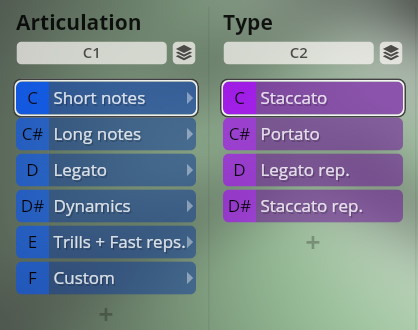
Long notes
Sustained notes, normal and with marcato crossfading. The articulation types are the same for the regular and Plus versions.
With the marcato option, use Dim.Ctrl/A (CC1) to add marcato attacks to the notes.
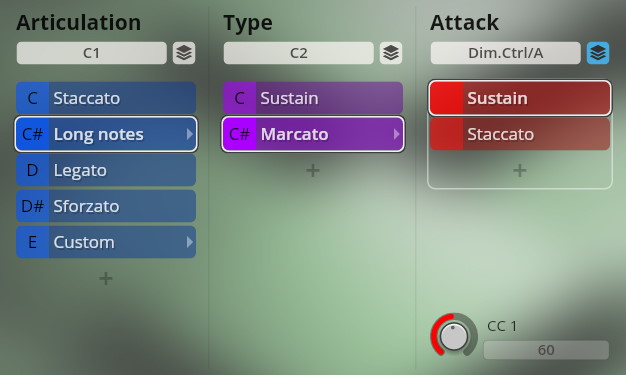
Legato
Performance legato, normal and with looped sustains. The articulation types are the same for the regular and Plus versions.
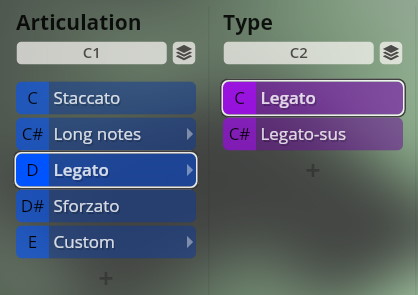
Sforzato / Dynamics
Regular
Sforzato.
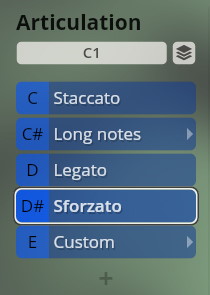
Plus
Sforzato and fortepiano.
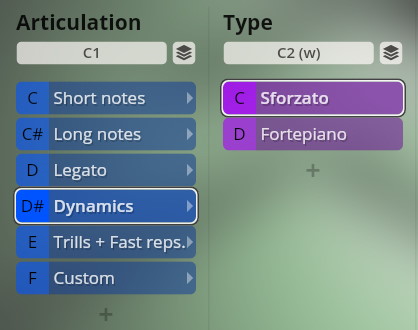
Trills + Fast repetitions (Plus only)
Half and whole tone trills, and fast repetitions at 150, 170, and 190 BPM. Please note that some wind instruments do not feature repetitions, while others cannot play proper trills, and therefore lack these Articulations. Accordingly, the slot names will only be "Trills" (e.g., oboes) or "Fast repetitions" (trombones).
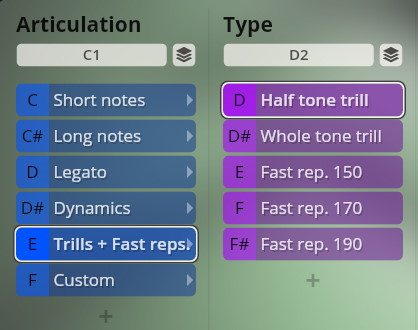
Percussion
01 Timpani
Single hits, secco, and rolls.
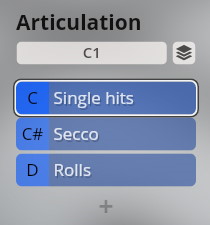
- Keyboard mapping
- Single hits and secco: A#1–C4 left hand, A#4–C7 right hand
- Rolls: A#1–C4 rolls, A#4–C7 single hits

02 Drums
Instruments: Taiko drum, bass drum, snare drum, snare drum ensemble (4 players), tambourine, and concert toms.
The slots are set to "Mix" mode, so that all instruments are available on the keyboard at the same time.
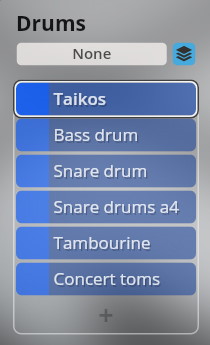
- Keyboard mapping
- Taiko: C2–B2
- Bass drum: C3–A3
- Snare drum: C4–A4
- Snare drums a4: C5–A5
- Tambourine: C6–A6
- Concert tom: C7–B7

03 Cymbals + Gongs
Instruments: Gongs, suspended cymbals, piatti, and tam-tam.
The slots are set to "Mix" mode, so that all instruments are available on the keyboard at the same time.
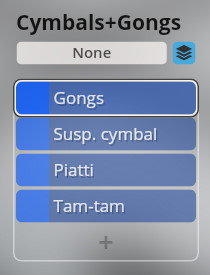
- Keyboard mapping
- Gongs: C2–A#4
- Suspended cymbals: C5–B5
- Piatti: C6–D#6
- Tam- tam: C7–D#7

04 Orchestral Percussion
Instruments: Thundersheet, rails, wind chimes, castanets, triangles, and crotales.
The slots are set to "Mix" mode, so that all instruments are available on the keyboard at the same time.
Transposition Keyswitches: the crotales can be switched between "88 keys" (A0) and "loco" (B0). The 88 keys option maps the crotales an octave lower than they sound, so that the entire Preset can be played on a regular keyboard.
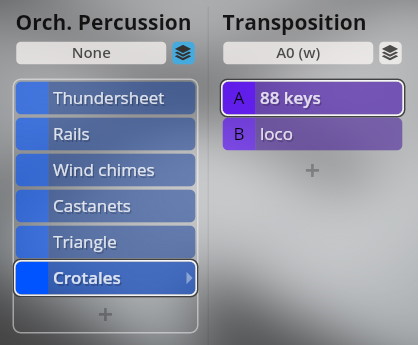
- Keyboard mapping
- Thundersheet: C1–B1
- Rails: C2–B2
- Wind chimes: C3–B3
- Castanets: C4–B4
- Triangle: C5–E5
- Crotales: F5–F#7 (loco: F6–F#8)

05 Bells
Instruments: Tubular bells, plate bells. There are no further options for these instruments.
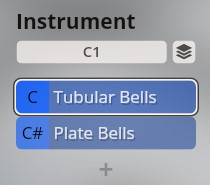
32 Keyboards + Mallets
01 Bosendorfer
Bösendorfer Imperial piano. Dim.Ctrl/A (CC64, sustain) reacts to the keyboard pedal for sustaining notes.
Range: C0–C8
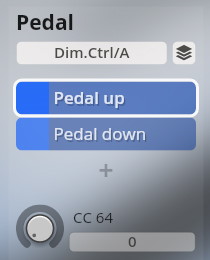
11 Celesta
Celesta, normal tones and soft attack.
Transposition Keyswitches: you can switch between "88 keys" (A0) and "loco" (B0). The 88 keys option maps the celesta an octave lower than it sounds, so that it will fit the range of a regular keyboard.
Range: C2–F7 (loco: C3–F8)
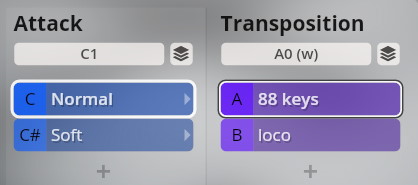
12 Glockenspiel
Glockenspiel, single notes.
Transposition Keyswitches: you can switch between "88 keys" (A0) and "loco" (B0). The 88 keys option maps the glockenspiel an octave lower than it sounds, so that it will fit the range of a regular keyboard.
Range: F4–D7 (loco: F5–D8)
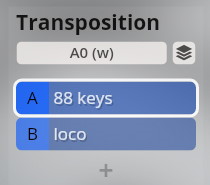
13 Xylophone
Xylophone, single notes.
Transposition Keyswitches: you can switch between "88 keys" (A0) and "loco" (B0). The 88 keys option maps the xylophone an octave lower than it sounds, so that it will fit the range of a regular keyboard.
Range: F3–C7 (loco: F4–C8)

14 Vibraphone
Vibraphone, single notes with and without motor (i.e., vibrato effect).
Range: D#3–G6
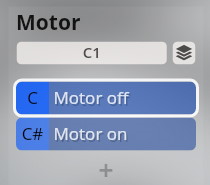
15 Marimbaphone
Marimbaphone, single notes.
Range: C2–C7
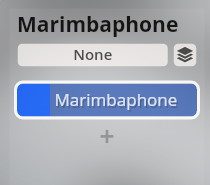
FX-Presets
FX Presets provide combinations of existing instruments and effects with the aim to create a special sound or mood. Most of them also use a dedicated controller to influence effect depth. The FX Presets are subdivided into categories according to their special sound quality.
01 Pads
01 Comfort & Pain
- Subtly developing pad based on wind instruments. Horn, clarinet, trombone.
- Modwheel CC1: Filter, Humanize, Return 2 Volume, adds FX and Depth.
02 Mirror Breeze
- Ringing pad with attack and filter modulation. Glockenspiel, celesta.
- Modwheel CC1: Filter control.
03 Infatuation
- Blissful pad for higher ranges. Piccolo flute, violin ensemble
- Modwheel CC1: Filter and Return 1 Volume, adds depth, thinning out the sound.
04 Timid Reaction
- Pulsating pad with filter FX. Tuba, double bass ensemble.
- ModWheel CC1: Return 2 Volume, FX.
05 Everflow
- Ringing pad with attack and filter modulation. Piano, celesta.
- ModWheel CC1: Filter control.
06 River Clouds
- Piano-based pad.
- ModWheel CC1: Channel 2 and 3 Volume, Cloud FX.
07 White Winds
- Celesta Attack paired with a humming pad. Piano, celesta, flute.
- ModWheel CC1: Channel 3 and 4 Volume, stutter flute.
02 Basses
01 Venom
- Evolving bass with synchronized stereo FX. Flute, Bb clarinet, contrabassoon, bass trombone, double bass ensemble.
- ModWheel CC1: Channel 4 Volume, adds depth.
02 Stutter & Shine
- String-based FX sound with a gated attack. Viola ensemble, double bass ensemble.
- ModWheel CC1: Channel 4 and 5 Volume, adds shimmering strings.
03 Incoming
- Virtualized double-bass with delays in sync and a haunting follow-up. Double bass ensemble staccato and sustained.
- ModWheel CC1: Return 1 Volume, adds depth.
04 Wowsers
- One-finger synchronized bass pad. Bass clarinet, double bass ensemble, cello, contrabassoon, bass trombone.
- ModWheel CC1: Channel 4 Volume, FX.
05 Wowtan
- Brassy bass with slapback and controlled sustain. Bass trombone, tuba.
- ModWheel CC1: Filter.
06 Catalyst
- Vibrant bass sound with a powerful attack. Double bass, double bass ensemble, celesta, tuba.
- ModWheel CC1: Return 3 Volume, thinning out the sound.
07 Copacectic
- Bass with highly satifactory filter control, synchronized. Cymbals & gongs, tuba.
- ModWheel CC1: Filter controls aggressiveness of the sound.
08 Whacky & Low
- Subtle, clear bass sound with highly effective changes through played velocities. Double bass, double bass ensemble, cello, cello ensemble.
- ModWheel CC1: Filter controls aggressiveness of the sound.
09 Stinger
- Hollow bass with filter control. Harp.
- ModWheel CC1: Filter control.
03 Plucks
01 Beauty & Chaos
- Light initial attack with synchronized delays. Viola ensemble, celesta, double bass ensemble, cello ensemble.
- ModWheel CC1: Filter control.
02 Slow Drop
- Double-attack sound drops. Harp, marimbaphone, celesta, glockenspiel.
- ModWheel CC1: Channel 2 to 4 Sends, adds depth.
03 Finding A Way
- Magical morphing sound. Violin ensemble, harp, viola ensemble.
- ModWheel CC1: Channel 4 and 5 Volume, Return Volume, adds shine and FX.
04 Southern
- Synth-like pluck sound with a touch of oboe. Viola ensemble, oboe, trumpet.
- ModWheel CC1: Adds Humanize effect.
05 Angel Harp
- Hybrid Harp, perfect for accompaniment or arpeggios. Harp, celesta, piano.
- ModWheel CC1: Channel 4 and 5 Sends, adds depth.
06 Hectic Decisions
- Xylophone attack with strings that follow. Xylophone, cello ensemble, celesta.
- ModWheel CC1: Return 2 Volume, adds depth.
07 Droplets
- Breathy drops of sound in space. Vibraphone, celesta, xylophone.
- ModWheel CC1: Channel 3 Send, adds depth.
08 Closing In
- Roomy portato violas with synchronized delay. Solo viola, détaché.
- ModWheel CC1: Filter control.
09 Splinter Hell
- Shattered pluck sound. Oboe, viola ensemble, cello ensemble.
- ModWheel CC1: Return 2 Volume, adds effected room.
10 Waiting Room
- Dull and still fascinating. We have all been there. Harp, horn ensemble, Bb clarinet.
- ModWheel CC1: Return 2 Volume, ringing Delay FX.
04 Hybrid Orchestra
01 Galactic Strings
- A soothing, spacious string pad. Cello ensemble, viola ensemble, violin ensemble, solo violin.
- ModWheel CC1: Return 1 Volume, Aux 1, adds depth.
02 Phases
- Morph through orchestral colors. Violin ensemble, solo violin, horn, clarinet.
- ModWheel CC1: Return 2 Volume, Reverb and Dim. Ctrl/A (Phases 1–3)
03 Rising Stars
- Slowly evolving pad, with fascinating FX. Viola ensemble, celesta, cello ensemble.
- ModWheel CC1: Channel 2 to 5 Sends, adds Depth.
04 Space Brass
- Mesmerizing Brass Sound, synchronized. Triple horn.
- ModWheel CC1: All Channel Sends, adds Depth.
05 Jade'n'Jagger
- Fragile combination of flute and portamento violin. Flute, violin.
- ModWheel CC1: Filter control.
06 Hybrid Horn & Strings
- Split-zone solo horn in the right hand and strong string section in the left hand. String ensembles, triple horn.
- ModWheel CC1: Filter control.
07 Bottleneck
- A golem mash-up of cellos and horns. Solo cello, horn ensemble, cello ensemble.
- ModWheel CC1: Filter and Tuning, higher tuning when sound gets filtered.
08 Through History
- Travel through time with this morphing piano sound.
- ModWheel CC1: Channel 1 and 2 Volume, switches between old and new piano sound.
09 Holy Keys
- Split-zone: Muted piano with a pad bass sound in the left hand. Tuba, piano, harp.
- ModWheel CC1: Channel 2 and 3 Volume, switches between soft and hard attack.
10 Black & White
- Split-zone virtual orchestra with ringing highs and screaming basses. Cello ensemble, double bass ensemble, contrabassoon, xylophone.
- ModWheel CC1: Filter control.